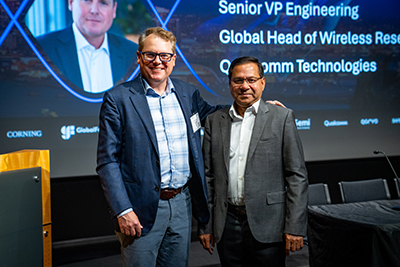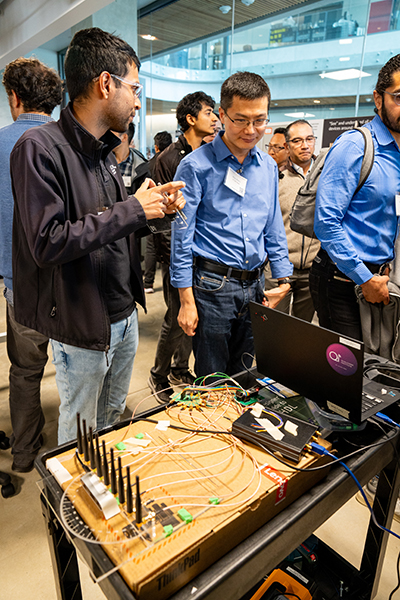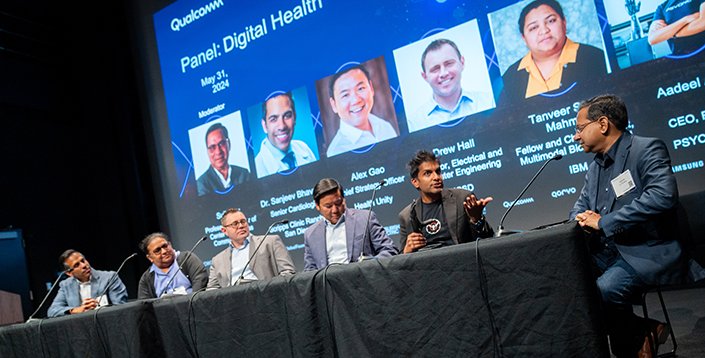How will AI Shape Next Generation Wireless?
UC San Diego, Qualcomm Technologies, Inc. hosted the San Diego Wireless Summit to discuss Wireless in the Era of AI
Story by:
Published Date
Article Content
With 5G network connectivity now a reality, wireless industry and academic research leaders met at the San Diego Wireless Summit to assess the state of 5G, and focus on how artificial intelligence could impact the capabilities of next-generation wireless systems in areas from digital health to digital twins. The summit, organized by UC San Diego’s Center for Wireless Communications, and co-sponsored for the first time by Qualcomm Technologies, Inc., drew c-suite executives from mobile operators including AT&T, T-Mobile, Verizon, and Docomo, as well as from vendors including Keysight, Ericsson, Nvidia, Qualcomm Technologies, Inc., Nokia Bell Labs, and the research community from UC San Diego to Samsung Research, Purdue, Rice, UCLA, and beyond.
“UC San Diego is world-renowned for the foundational wireless communications research conducted here, from our beginnings with Qualcomm founder Irwin Jacobs through to today with our pivotal work on RF antennas, sensor networks, signal processing, and more,” said Sujit Dey, professor of electrical and computer engineering at UC San Diego and director of the Jacobs School of Engineering’s Center for Wireless Communications. “Over the last decade, we have also invested in multi-disciplinary programs researching how novel use cases in transportation, health, and immersive media can be enabled by, and can inform, the advances in wireless communications. Hosting this summit with Qualcomm Technologies, Inc. and our industry members is a testament to the role that the San Diego region as a whole plays in the industry, and I’m pleased to have facilitated so many thought-provoking discussions and panels with wireless leaders from around the world.”
One of those wireless leaders was John Smee, Senior Vice President of Engineering and Head of Wireless Research at Qualcomm Technologies, Inc.

"Our collaboration with UC San Diego's Center for Wireless Communications underscores Qualcomm's deep commitment to pioneering the future of wireless technology alongside academic and industry leaders. This collaboration is not just about advancing technology but also about creating a vibrant ecosystem in the San Diego region that drives innovation and sets global benchmarks. Together, we are pushing the boundaries of what's possible in wireless communications and AI, from enhancing connected digital health to developing industrial digital twins, ensuring that we remain at the forefront exploring new technologies." — John Smee, Senior Vice President of Engineering, Qualcomm Technologies, Inc.
The message from the panelists was that while it’s not too early to think about 6G, there are many innovations that will occur in the intervening years before the first commercial rollouts of 6G connectivity in 2030. As Rob Soni, Vice President of Radio Access Network (RAN) Technology at AT&T put it, innovation doesn’t happen on 10-year cycles, so AT&T uses the phrase “NextG” to incorporate all of the improvements and changes that will happen before 6G hits the networks. With three times more devices predicted to be in the average household by 2030 and four times more data on the networks in the next five years, AI poses both opportunities and challenges to deal with this continued growth of network connectivity needs.
Future of Wireless Communications
While the promise of the proliferation of Internet of Things (IoT) hasn’t yet quite been realized, experts predict that the number of these smart, connected devices will continue to grow in the next few years, as AI enables the data they collect to actually be parsed, and an increasing focus on sustainability means low or even no-power ambient IoT devices will be increasingly in demand.
Karri Kuoppamaki, Senior Vice President at T-Mobile, noted that the reason IoT didn’t take off as expected isn’t because there’s no need for these applications, but rather because of market fragmentation and complexity driving up their cost. As the costs decrease, he expects demand for IoT devices will continue to grow.
In what sectors will these IoT devices proliferate? The automotive sphere is one major area, where increasing automation relies on these sensors and software. Misha Dohler, Vice President at Ericsson, said he believes there will also be significant IoT growth in “droids and drones,” meaning delivery and passenger drones, as well as robots.
Another area where 5G technology is expected to grow in the coming years is in native 5G-connected devices, versus WiFi-connected devices such as laptops or iPads. Not only will this provide more reliable connectivity, but these devices with built-in 5G could also help bridge the digital divide in areas like education, where not all zip codes have access to fast-speed, reliable wireless internet.

The impediment to the adoption of these devices isn’t a technical one but mostly centers around issues of cost and a not entirely seamless process for the consumer. Carl Nuzman, a Bell Labs Fellow at Nokia Bell Labs, said AI could assist in this area by knowing how and when users want to toggle between devices and helping with the sometimes complicated initial setup of new devices.
Among the challenges facing next-generation wireless communications are technical issues—how to increase the sustainability of networks and enable data sharing between operators to take advantage of AI's promise—as well as non-technical issues, from declining populations in much of the world to business model challenges and workforce development needs.
Maintaining a workforce with a solid background in communication fundamentals in the era of AI is one educational challenge that Robert Heath, Charles Lee Powell Chair in Wireless Communication and professor in electrical and computer engineering at UC San Diego, cautioned his industry counterparts to be wary of.
“One of the challenges is that we see a shift of interest from students into AI-driven fields,” said Heath. “I think that’s definitely going to be a concern for my industry colleagues in communications. UC San Diego has strength in teaching the fundamentals derived from mathematical models: communications theory and information theory. Model-based thinking is incredibly important for building intuition and making design decisions. We won't leave every decision about how to design and build a communication system up to a machine that uses data-driven models. And what I see is that aside from a few isolated schools like UC San Diego, you're going to see vastly fewer engineers trained that have that thinking. I would be concerned about the prospects of hiring engineers with only a background in machine learning, without knowledge of communication fundamentals.”
Training students to have technical competencies in artificial intelligence is important, but not at the expense of communication fundamentals, said Thomas Cheng, principal researcher at Ericsson. He said he’s found that it’s easier to train someone with a good wireless background on AI skills, but the opposite is very difficult.
One challenge both created by and potentially solved by AI is the very large and growing rate of video traffic on the networks- for example, Soni from AT&T said video accounts for 60 -70% of their network traffic. Much of this is thanks to social media and streaming platforms pushing up to 10 video streams to a single device simultaneously, allowing users to advance or toggle between streams. While AI algorithms are partly to blame for generating these streams of content, there is also an opportunity for AI tools to be used to reduce the load of this video traffic.
Two areas of future wireless growth explored in depth were in digital health and digital twin technology.
Digital Health
The high speed, reliability and low latency of 5G enabled a boom in the digital health market, from robotic-assisted and telesurgeries, to a proliferation of wearable sensors and monitors. What will advancements in wireless technology and in AI bring to this space?
Experts said the number of extremely low, or even zero-power biological sensors will increase, enabling continuous monitoring of specific biomarkers.
“We actually developed one of the lowest power injectable biosensors ever reported,” said Drew Hall, professor of electrical and computer engineering at UC San Diego. “It uses less than a microwatt of power. The implanted sensor is injected under the skin where it wirelessly receives power and wirelessly transmits data back to a wearable device. There’s a lot of opportunities coming up in this space that haven’t been tapped on the healthcare side of sensors that will start to get figured out due to a clear regulatory pathway.”
Lowering the power consumption for wearable devices will enable more of these rings, earbuds, patches, and watches to provide continuous data streams, providing a more holistic picture of patient health. Alex Gao, Chief Strategy Officer for Health Unity, said this continuous data could be used to predict COPD exacerbation, congestive heart failure exacerbation, and even predict asthma attacks or seizures before they happen. He noted that combining this constant flow of data with generative AI tools capable of sifting through the information to make accurate predictions will enable much more personalized treatments for patients. The key from an AI perspective is to reduce hallucination, and ensure clinical efficacy is high.
Tanveer Syeda-Mahmood, IBM Fellow and Chief Scientist for Multimodal Bioinspired AI, said hallucinations aren’t the only challenge going forward. She said sourcing and standardizing all of this data is also an issue, as is ensuring the AI algorithms are precise enough for health use cases, where an AI tool could be asked to locate a stent within the coronary artery, and an accuracy within a few millimeters is required. Lastly, she noted that getting clinicians to adopt these AI workflows into their existing practices has been a challenge.
Digital Twins
When talking about digital twins, it’s first crucial to understand what a digital twin is, and how it differs from a simulation, emulation, or model of a system.
Rajive Bagrodia, chief technologist for Network Digital Twins at Keysight Technologies, explained that a digital twin can be either a simulation or an emulation of a device, system, or network, but the key is that it must be connected to the physical twin, with the ability to communicate with the physical twin regularly to help optimize and improve the physical version.
Digital twins are used in a variety of industries, from civil engineering to computer science, to improve the performance of the physical version. In the context of wireless networks, John Macias, an associate fellow in Systems Architecture at Verizon, said they’re very useful when planning to roll out new features or assets. Verizon will choreograph sending out network parameter updates using a digital twin to see in granular detail how it will impact the network. This information will be used to most effectively implement the roll out in a much more confident manner.
Tommaso Balercia, Principal Architect at Nvidia, agreed that digital twins in a wireless context are excellent tools for effectively designing, deploying and then managing operations, noting that the focus at Nvidia is on the design stage, in an attempt to catch problems earlier on, before the operation or management stage.
Rajeev Chhajer, Chief Engineer & Research Domain Leader at Honda, added that digital twins will also play an important role in better understanding existing mobility options and choices in urban areas, and then designing more effective smart transportation systems.
Center for Wireless Communications
UC San Diego's Center for Wireless Communications was founded in March 1995 as a partnership between the university and the wireless communications industry. Its goals include the definition and pursuit of a cutting-edge program of precompetitive, multidisciplinary research focused on wireless access systems, technologies, and applications; the creation of a relevant base of new knowledge with high commercial impact potential; and the production of graduates at all degree levels to meet industrial human resources needs. Learn more about CWC here: https://cwc.ucsd.edu/

Share This:
You May Also Like
UC San Diego is Strengthening U.S. Semiconductor Innovation and Workforce Development
Technology & EngineeringStay in the Know
Keep up with all the latest from UC San Diego. Subscribe to the newsletter today.




